ARTNOUVEAU2 - ENRICHING KNOWLEDGE ABOUT ART NOUVEAU ONLINE
30-06-2022
Within the ArtNouveau2 project, we place emphasis on the promotion of cultural heritage through the joint action of all partners making posts on social media with the activity Enriching knowledge about Art Nouveau online.
Read what we have prepared in June on the common topic of Art Nouveau Typography which is the theme of this year’s World Art Nouveau Day (10 June 2022):
ARTISTIC TYPOGRAPHY IN AUSTRIA:
Rudolf von Larisch (1856–1934) – Beispiele künstlerischer Schrift 1900–1910 [Examples of Artistic Typography]
Graphic artist and typography artist Rudolf von Larisch revived typography art around 1900. His work Beispiele künstlerischer Schrift 1900–1910 [Examples of Artistic Typography 1900-1910], which consists of four volumes, compiles a collection of the best decorative typography of his time. His goal was to present the development of ornamental “contemporary” typography, thus giving it new significance. He transformed letters and numbers to real works of art—be it on his posters, in his books, or on buildings.
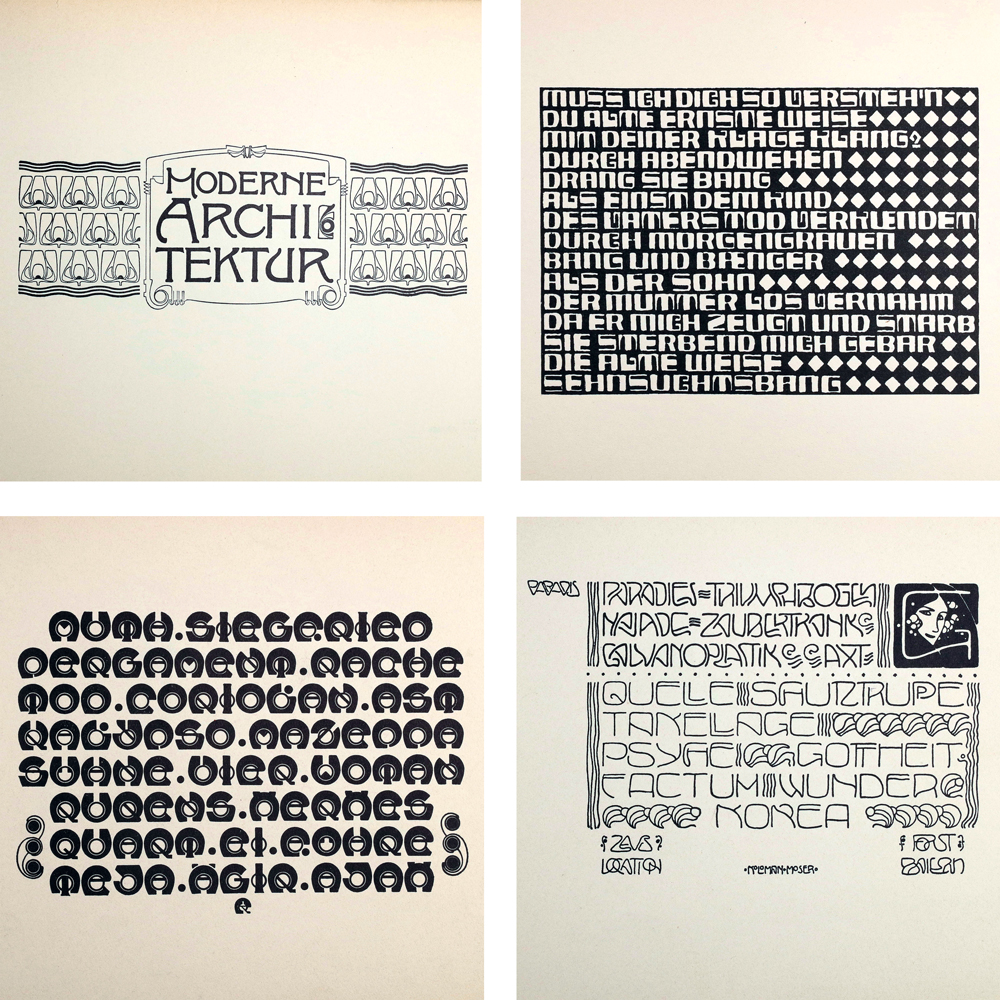
Copyright:
1. Otto Wagner, Beispiele künstlerischer Schrift 1900–1910 [Examples of Artistic Typography 1900–1910], ed. by Rudolf von Larisch, Scan © MAK
2. Carl Otto Czeschka, Scan © MAK
3. Adalbert Carl Fischl, Scan © MAK
4. Coloman Moser, Scan © MAK
ARTISTIC TYPOGRAPHY IN SLOVAKIA:
Although there is not much of Art Nouveau typography to be seen on architectural façades of buildings in Bratislava, but where we can find it, apart from posters, surprisingly also in the common press of that time. For example the "Dennica" magazine: An illustrated family review for literature and social issues used an Art Nouveau styled typography not only for its title, but also for the titles of individual sections, as for: Kronika (Chronicle), Ručné práce (Handicrafts), Rady pre domácnosť (Household advice) or Pre kuchyňu (For the kitchen).

Photo credit: "Dennica" magazine, Vol. XI, #7, July 1908
ARTISTIC TYPOGRAPHY IN CROATIA:
Looking at the architectural buildings of this time, did you notice the applied signatures on the facades? Namely, the signatures of architects / authors are common on Art Nouveau buildings, but this is not the only way in which artists of that time applied typography. The use of monograms is another way of applying typography in the time of secession. A monogram is an abbreviation for a person's name, usually initials written in the form of a single sign consisting of one, two or all letters of a person's name. Monograms have been known to us from coins since before Christ, and everyone may be familiar with the monogram of the Renaissance artist Albrecht Dürer. The Art Nouveau monogram on the author's works consists of the initials of the artist inscribed in a square frame, ie the initials of the manufactory, inscribed in a circular frame. Art Nouveau monograms can be said to be the symbol and logo that make up the identity of a particular artist.

Photo credit: Dragan Melkus publishing house: Club of Croatian writers and artists Osijek press: the first Croatian joint-stock printing house, 1910, magazine © Museum of Slavonia
ARTISTIC TYPOGRAPHY IN ROMANIA:
As is already known, one of the characteristics of the Art Nouveau movement is that it influenced not only the major fine arts but also the decorative arts and, implicitly, the graphics of books, publications and posters. Internationally, at the end of the 19th century, Art Nouveau was already in fashion, its ornamentation, curved shapes and emphasis on graphics inspired print designers. Art magazines and others began to be published in an avant-garde spirit, where text became part of the composition of the illustration. "Jugend”, the art magazine founded in Munich in 1896, became famous for promoting the new style and artists such as Otto Eckmann illustrated its pages. He is also the designer of the "Eckmann" font, a special font created in the spirit of Art Nouveau that became very popular.
In Romania, the trend has been penetrating since the end of the 19th century, and in the plastic and decorative arts it overlaps with the effervescent spirit of the new era. Artists such as Ștefan Luchian, Constantin Artachino and Nicolae Vermont set up the "Ileana" art society, whose name refers to c Ileana Cosânzeana –a fantasy character and the symbolism of spring. This society positioned itself as an alternative to the official art movement and set out to popularize modern works of art. Around 1900 - the society's publication, "Ileana" magazine, modelled after the one in Munich, also appeared. Like "Jugend", the magazine "Ileana" aimed to cultivate the local public taste and to contribute to the penetration of art into everyday life. The magazine’s founders were Alexandru Bogdan-Pitești and Ion C. Bacalbașa and the artists invited to populate the pages of the magazine were among the members of the Society. The magazine's graphics were in the spirit of Art Nouveau, the covers and frontispieces having floral and geometric decorations, wavy or "serpentine" lines generally framing a female allegory. The illustrators were the same artists of the time, including Stefan Luchian, Arthur Verona, Kimon Loghi, as well as famous foreign guests such as Alphonse Mucha.
Several publications adopted the modern graphics of the beginning of the century, many of which were printed at the Minerva Graphic Arts Company founded in 1898, which in 1902 was called the Minerva Graphic Arts Institute and Publishing House and in 1910 became the Minerva Publishing Company. One of the publishing house's first projects was the daily newspaper “România Jună / Young Romania”, where the Minerva Calendar was
published in 1900, a 227-page publication with Art Nouveau graphics and vegetal illustrations. One of the prominent illustrators and collaborator of the Minerva Institute of Graphic Arts was Rola Piekarski, an artist of Polish origin who is known for locally introducing the Art Nouveau style in book graphics. He also collaborated with the “Furnica” Magazine, a humorous weekly that appeared in 1904, in line with the modern style of the turn of the century. The Minerva newspaper, published in 1908, includes a supplement of Illustrated Literature where the frontispieces of the covers are designed in a stylized and geometric manner. The “Albina”, a "popular encyclopaedic" magazine, has been using the graphics and fonts of the new style since 1900.
The poster also reflects the same taste for renewal, flourishing and dynamism. The poster’s new character as a "miniature show" and not as a printed page is found in the work of Nicolae Vermont for the opening of the "Independents' Exhibition" and Constantin Artachino for the "Ileana" Society series of conferences . Apcar Baltazar, a versatile artist of Armenian origin who produced numerous poster designs marking the events of the time, including the 1904 Exhibition of the Agrarian Society, should also be mentioned.
The influences of the new style that entered Romania at the end of the 19th century and the beginning of the 20th century in architecture, painting, decorative arts, furniture, can also be found in the graphic arts, in illustrations for books and magazines, in the decorations accompanying various prints and manuscripts. All this brings Romanian artistic creation in line with the international movement in the rest of Europe.


Photo credit:
Minerva Calendar, photo credit dacoromanica.ro
Art Nouveau Typography and graphics Romania Collage, multiple Archive sources, credit photo dacoromanica.ro
SONNEFELD TYPOGRAPHY
In the middle of the 19th century, the Oradea printing houses were a reproduction of workshops with variable investments, and as for the purchased technology, it will allow different techniques, from lithography to mechanical press. With the liberalization of the market, they will invest in modern equipment. Therefore, companies will start their activity as individual or family companies, some of which will become joint-stock companies at the beginning of the twentieth century, then joint stock companies. Speaking of beginnings, these printing workshops meant only a segment in the entrepreneur's activities. Some began working as booksellers and stationers, then set up printing houses next to their stores. The wholesale and retail trade of paper was more profitable and the area of paper merchants expanded to Central Europe. In the monography of Bihor county edited by Samu Borovszky [Bihar vármegye és Nagyvárad, op. cit., pp. 307-308] in 1902, the printing industry is treated as a reproduction industry in addition to the activity of photographers and painters of companies. When the local newspapers has been issued, the investment became profitable in the short term, and the publishing house next to the printing house diversified its area of possible customers. The route of the Sonnenfeld family illustrates this type of enterprise.
In 1856, Simon Sonnenfeld (1829-1876), set up a printing house, which, under his leadership and that of his successors, developed more and more, becoming one of the most important graphic workshops in the western area, and after 1919, one of the most efficient printing houses in Romania.
 Simon Sonnenfeld, 1856, photo from the Gabriel Sonnenfeld archive
Simon Sonnenfeld, 1856, photo from the Gabriel Sonnenfeld archive
Adolf Sonnenfeld, specialist in the field of office supplies in 1886 opens his own shop in Ferdinand Square (Bémer tér) no.3. The Adolf Sonnenfeld family had their home above the shop, behind the shop they arranged a printing house and will start their activity with lithography, relief printing and compaction. From this enterprise will develop, around 1910, an industrial enterprise that will compete with similar important enterprises in Budapest.
 Adolf Sonnenfeld, Jewish History Collection Archive, Oradea (oil painting, replica), 1886
Adolf Sonnenfeld, Jewish History Collection Archive, Oradea (oil painting, replica), 1886
Adolf had married Irén Spiegl from Budapest, the sister of the famous Art Nouveau buildings architect, Frigyes Spiegl (Spiegel). They had three children: Gusztáv Sonnenfeld (1890-1918), Andor Sonnenfeld (1892-1947) and Paula Sonnenfeld (1897-1944 Auschwitz). The Adolf Sonnenfeld family had their house above the shop, then in 1899, the business prospering, they will move to a new house, on Aurel Lazăr street number 7. Their house was the first building built in Art Nouveau style in Oradea, build according to architectural plan of Frigyes Spiegl (a small printing hall was designed in the basement of the house).
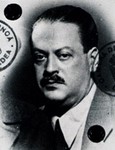 Archive, History of the Jews Collection from Oradea, (photo, ID card for an typograph) 1910
Archive, History of the Jews Collection from Oradea, (photo, ID card for an typograph) 1910
Between 1911-1912, they will build a three levels store palace in Viennese secession (empire) style, str. Moscovei (Apáca u.) No. 8, and this time also according to the plans of Frigyes Spiegl. The two levels store printing house building was placed inside the courtyard, which included two production halls and several workshops. On the street front they opened several shops, in the interwar period here were arranged the editorial offices of local newspapers, where they were shareholders or became their property:

Nagyvárad (Oradea) and also Szabadság (Freedom), Nagyváradi Napló (Napló 1936) (Oradea Journal; Journal, 1936).
“Nagyvárad” printing and newspaper company S.A. was established in 1914 by the owners of the Sonnenfeld company as a joint-stock company, a joint-stock company based on Bulevard King Carol no. 6 (str. Moscovei). Their sons, Gustáv Sonnenfeld and Andrei Sonnenfeld, learned the secrets of the trade in the West, in London and in Budapest, respectively, and then set up a joint-stock company in 1916
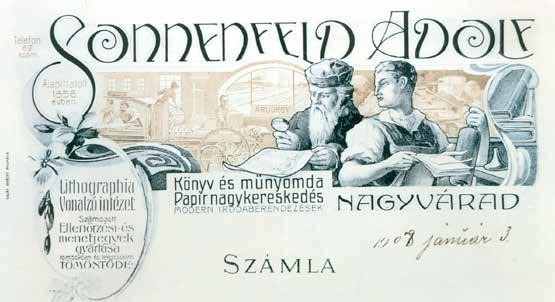 Invoice header, 1908
Invoice header, 1908
In 1920, the printing house had 6 linotype machines, next to which an 8-page rotary machine will be installed.In 1922 they will start another investment, the first relief printing house in Romania, under the name "Sunfild". From 1925 they will set up a new production line "Pelican Mill", the factory of envelopes and paper. In 1929, in addition to the "Pallas" lithography department, they set up a cartboard section, a rotary ticket machine. Sonnenfeld enterprise of the year 1938 will take the name "Graphics" Institute of Graphic Arts, which will print most newspapers from Oradea, in Romanian and Hungarian: Gazeta de Vest, 1921-1928, periodical Family magazine, 1934-1940, Romanian Progress, 1938, People's Will, 1945-48, newspaper Nagyvárad, (Oradea), 1919-1943, Nagyváradi Esti Lap. (Evening magazine).
In 1946 the owners will start an enterprise called "Grafica", a collective name partnership,since 1947 "Grafica" Sonnenfeld and Friedländer, and in 1948 was the basis "Crişana" Printing Company, later an enterprise known as Imprimerie de Vest. Since the 1900s, members of the Sonnenfeld family have been actively involved in the development of the city, in the cultural, social and sporting life of the city. They had commercial and financial relations with various foreign companies, traveled, purchased valuable art objects and were the first to bring the Art Nouveau architectural style to Oradea in 1899. Their prints reached the aesthetic and professional standards of the time. They had a special contribution to the editing of the poetry volumes of the modernist group "A Holnap" (Tomorrow), in 1908 and 1909. The few small prints that remained reflect the professional demands of themselves and their employees. Being also book publishers, writers and journalists also worked at their publishing house, the illustrations were made by the best graphic artists and painters (Ernő Grünbaum, Leon Alex, István Balogh and others).
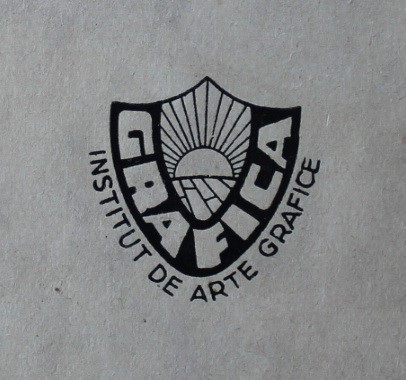
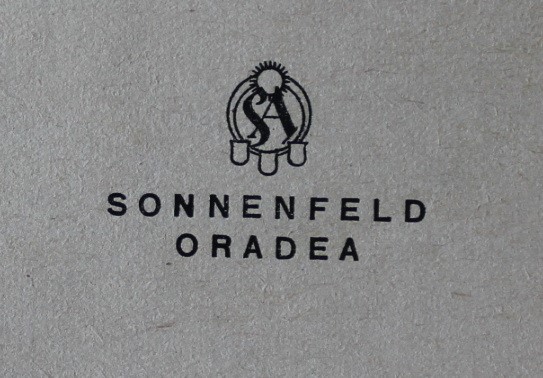
1946 from the collection of the “Gh. Șincai” County Library, Bihor, Oradea
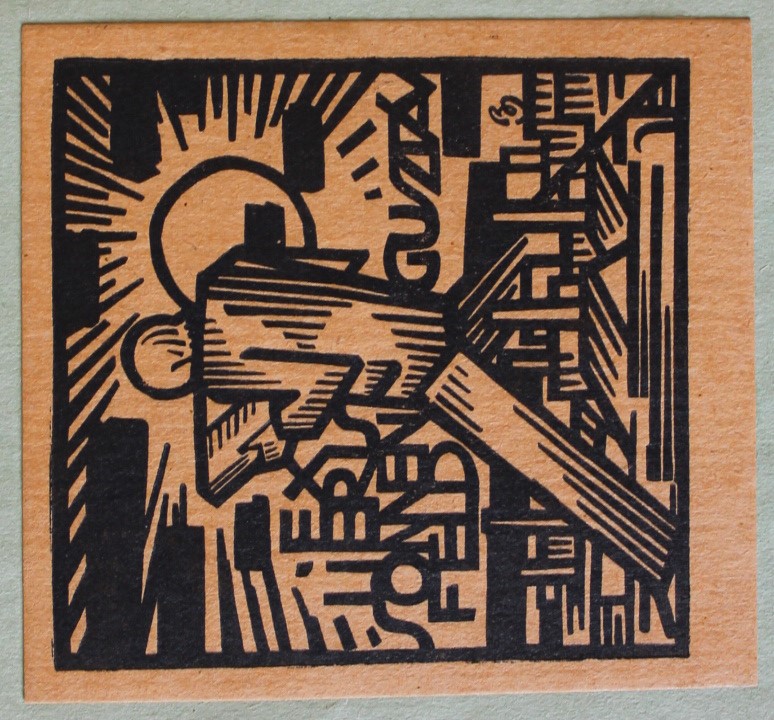
Libris Sonnenfeld Gusztáv, illustration by Istvan Balogh (from the collection of the “Gh. Șincai” County Library, Bihor, Oradea, 1908
Lead partner: City of Oradea (Oradea Municipality)
Other partners: Oradea Heritage and Foundation for Protection of Historical Monuments from Bihor County; National Institute of Heritage, Bucharest; Iparművészeti Múzeum, Budapest; Museum of Arts and Crafts, Zagreb; Museum of Applied Arts, Vienna; Slovak University of Technology, Bratislava; Republic Institute for Protection of Cultural Monuments, Belgrade; Kodolányi János University, Budapest.
Project co-funded by European Union funds (ERDF, IPA II).
